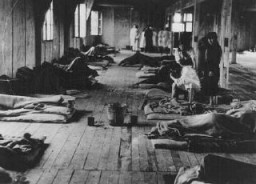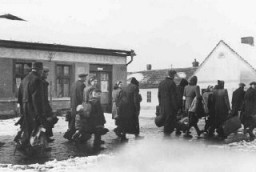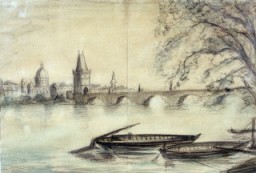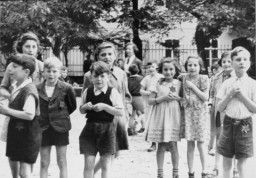
Theresienstadt: "Retirement Settlement" for German and Austrian Jews
Before June 1942, Protectorate Jews were the only "residents" of the Theresienstadt camp-ghetto. Beginning with a transport of 50 Berlin Jews arriving on June 2, 1942, the German authorities deported German, Austrian, Danziger, Luxembourger, and Sudeten Jews to Theresienstadt.
Deportations
In 1942, 47,478 Jews arrived in Theresienstadt from the Greater German Reich (from Germany, 32,878; Austria, 13,922; Luxembourg, 213; Danzig, 110; and the Sudetenland, 355).
In 1943, 5,398 Jews arrived in the camp-ghetto from the Reich (from Germany, 5,281; Luxembourg, 96; Sudetenland, 17; and Danzig, 4).
In 1944, the camp-ghetto received 1,983 Jews from the Reich (from Germany, 1,671; Austria, 227; Sudetenland 81, Danzig: 3; and Luxembourg, 1).
Finally, up to April 20, 1945, in 1945, 2,134 Jews from the Greater German Reich were deported to Theresienstadt (from Germany, 1,954; Sudetenland, 158; Austria, 22).
In all, between June 2, 1942, and April 20, 1945, 58,087 Jews from the Greater German Reich arrived in Theresienstadt (from Germany, 41, 783; Austria 15,266; Sudetenland, 611; Luxembourg, 310; and Danzig, 117).
Of these 58,087 Jews from the Greater German Reich, the Germans deported 23,670 (16,098 from Germany, Danzig, the Sudetenland, and Luxembourg; and 7,572 from Austria), nearly 41%, to killing centers or sites in the East.
Administration of the Camp-Ghetto
Although the deportations in and out of Theresienstadt illustrate its key function as a transit camp, the facility was also a ghetto. Though Jews were incarcerated in the camp, unlike actual concentration and transit camps, they lived under a Jewish administration. Until January 1943, Jakob Edelstein chaired the Council of Elders, though in the autumn of 1942, he found himself overshadowed and outmaneuvered by German and Austrian leaders. In January 1943, Adolf Eichmann, seeking to keep the Jewish leadership divided and therefore passive, decided to appoint Paul Eppstein of Berlin and Benjamin Mermelstein of Vienna to make a triumvirate leadership of the Council, with Eppstein as the sole liaison to the SS management.
Though completely beholden to the German authorities for implementing orders and making selections for the deportations, the Jewish Council of Elders also functioned as a quasi-municipal authority as well as the management of a forced-labor camp. The Council organized municipal services, such as housing, electricity and water, sewage and sanitation, policing, and religious, judicial, and postal services. It also acted as a central coordinating body to organize personnel for labor detachments.
Among the labor details at which Theresienstadt "residents" worked were various workshops within the camp-ghetto, including carpentry, leather goods, tailoring, and machine shops. The council assigned women to work in the kitchen, clean the barracks and common rooms, work in the camp-ghetto's vegetable gardens, and serve as nurses or orderlies in the so-called sick rooms. The most unlucky "residents" worked outside the camp on construction projects and in the nearby Kladno mines, mostly under direct SS and police supervision.
Finally, the Council of Elders organized educational activities, cultural events and religious celebrations. Since the SS cared little for what went on inside the camp-ghetto or what the "residents" did in their free time (Freizeitgestaltung) as long as it did not involve subversion, sabotage, or breaking the rules of the camp-ghetto, the Council had significant autonomy in organizing these events.
In all these elements, including the fact that prisoners wore civilian clothes, Theresienstadt more resembled a ghetto than a concentration camp. Of course, there was a dreadful downside to this autonomy: the Council of Elders had the autonomy to ration food, which they steered towards those who could work, leaving the elderly and disabled more vulnerable to disease and starvation. More serious yet was the discretion of the Council Members to choose who would be deported and who would remain—who would have the chance to live and who would die.
"Model Jewish City"
The Jewish leaders operated under the assumption that labor productivity and obedience to the Germans would facilitate the development of Theresienstadt into a model Jewish city and permit the survival of most of its inhabitants, an illusion to which some ghetto "residents" clung even after the first deportations in January 1942. The SS management showed initiative in playing along. To maintain the illusion for domestic consumption, regional German authorities lulled the elderly, war veterans, and prominent personages with ruses such as home purchase contracts, "deposits" for rent and board, inducements for future "residents" to sign life insurance policies over to the German state.
With their arrival in mid-1942, German and Austrian Jews became the majority among "permanent" residents at Theresienstadt, as most of the Czech Jews had already been deported East. In August 1942, the Germans permitted the establishment of a Bank of the Jewish Self-Administration with special paper currency notes depicting Moses holding the tablets of the law. During the second half of 1942, the SS management funneled funds from confiscated Jewish property into the hands of the Council of Elders to finance improvements. Yet the dark backdrop of deportations was ever-present against the efforts to make the facility livable for its average population of around 45,000 inhabitants.
In the summer of 1942, with Theresienstadt temporarily almost empty, the Council of Elders allotted several large houses to accommodate children. A most important spiritual legacy of the camp-ghetto and its administration was the attention given to the welfare and education of the children. The hope was to keep the children separate from the adults and hence reduce their vulnerability to depression and despair. In general, thanks to these efforts, the children were better housed and fed than the adults, and had the opportunity to learn from some of the most sophisticated pedagogues and teachers in German-speaking Central Europe, who were among the prominent Jews arriving in Theresienstadt.
In fact, 247 children were born in the camp-ghetto between November 1941 and April 20, 1945, and five more in the last two weeks of the war. Among the pains taken for the sake of the children were education and encouragement for them to find solace and hone skills in drawing and painting. Nearly 600 of the almost 10,000 children who entered Theresienstadt at one time or another, are known to have drawn or painted works under the guidance of such teachers as the famous Austrian Jewish artist Friedl Dicker-Brandeis.
Series: Theresienstadt
Critical Thinking Questions
- What was the role of Theresienstadt in the Nazi strategy of deception? How was it different from the majority of concentration camps and ghettos?
- Did other camps have multiple purposes? If so, what were they?
- Euphemisms, mild or indirect words or expressions substituted for ones considered to be too harsh or blunt, can hide dangerous or illegal behavior. What expressions did the Nazis use to disguise their intentions or policies?







